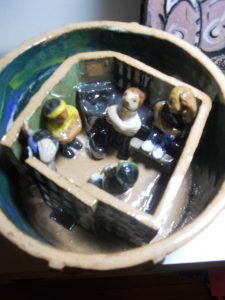 I had the privilege to visit Project Onwardin Chicago. I was curious to see a collective artist studio in operation. I have heard so much about Creative Growth in California and I understood that Project Onward was developed with similar goals. Their mission statement:
I had the privilege to visit Project Onwardin Chicago. I was curious to see a collective artist studio in operation. I have heard so much about Creative Growth in California and I understood that Project Onward was developed with similar goals. Their mission statement:
Project onward supports the career development of adult artists with mental and developmental disabilities. Artists receive work space, materials and professional guidance as well as exhibition opportunities and 60% from artwork sales.
For many adults with developmental disabilities and mental illness, social life can be challenging. In the studio, gallery and outside events, artists develop important personal and professional relationships which create lasting impact on the people who engage with the artists and the artists themselves.
Supporting Project Onward means you are broadening our community, giving our artists the chance to meet and interact with new people and offering opportunities for our artists to develop their artistic careers.
(I truly wish we could discard the notion that outsider artists are those with mental health and developmental disabilities. But I digress. I will save my exploration of this topic for my MA thesis.)
Project Onward has recently moved to a new location. The down side is that it’s a long way for those without a car (57 bus stops, to be exact); the upside is that it has oodles of space. The workshop itself is a room full of tables for the artists to work. Project Onward can accommodate about 20 artists (if I remember correctly) and interested artists apply with a sample of their artwork. At the moment there are about 15 artists at work – 14 men and 1 woman. Artwork ranges from detailed pencil drawings to beautiful oils. Artwork is for sale, and the prices are more than reasonable. I went to Project Onward on my last day in Chicago. If my suitcases weren’t bursting and my credit card wasn’t ready to catch fire, I would have bought 5 or 6 pieces of artwork. The best I could do was to keep a wish list of work that I hope to buy some day. Check out the artists’ work on their website.
One of the fun features of Project Onward is that an artist of your choosing will do your portrait for $20. I asked to sit for Adam E. Hines, a young man in his late 20s. He was delighted to be asked and we had an interesting chat while he was working.
I learned two things about Adam. First, Adam is the lead singer in an R&B band, DHF Express. Second, Adam has a remarkable memory. It seems that he remembers everything – images, conversations, information – everything. Of course I don’t know if that is true, but it sure seemed so. I noticed a collection of artwork by his desk and sorted through them while he was working. I noticed a painting of a Vancouver (Canada) landmark – the Pan Pacific hotel, with its distinctive “sails” above the conference centre. I asked Adam if he had been to Vancouver. No. So why did he get the idea to paint this building? He said he saw it in a magazine or on TV or something and remembered it. The other paintings were of other city scenes from around the world. Although Adam has not travelled to these places, he takes virtual journeys to them through his artwork. And not only did he remember the name of the friend that I was with, he remembered the name of her grandson, whom he did a portrait for THREE YEARS AGO! I’m one of those people who can’t remember the name of someone I’ve just met, so I was more than envious…
 So, my portrait. What do you think? I should smile more, and I should get Botox for my wrinkled brow. But I was kind of flattered – my clothes match nicely, my hair looks neat, and I have a fresh application of red lipstick. And I’m #1. I will remember to keep it real.
So, my portrait. What do you think? I should smile more, and I should get Botox for my wrinkled brow. But I was kind of flattered – my clothes match nicely, my hair looks neat, and I have a fresh application of red lipstick. And I’m #1. I will remember to keep it real.


